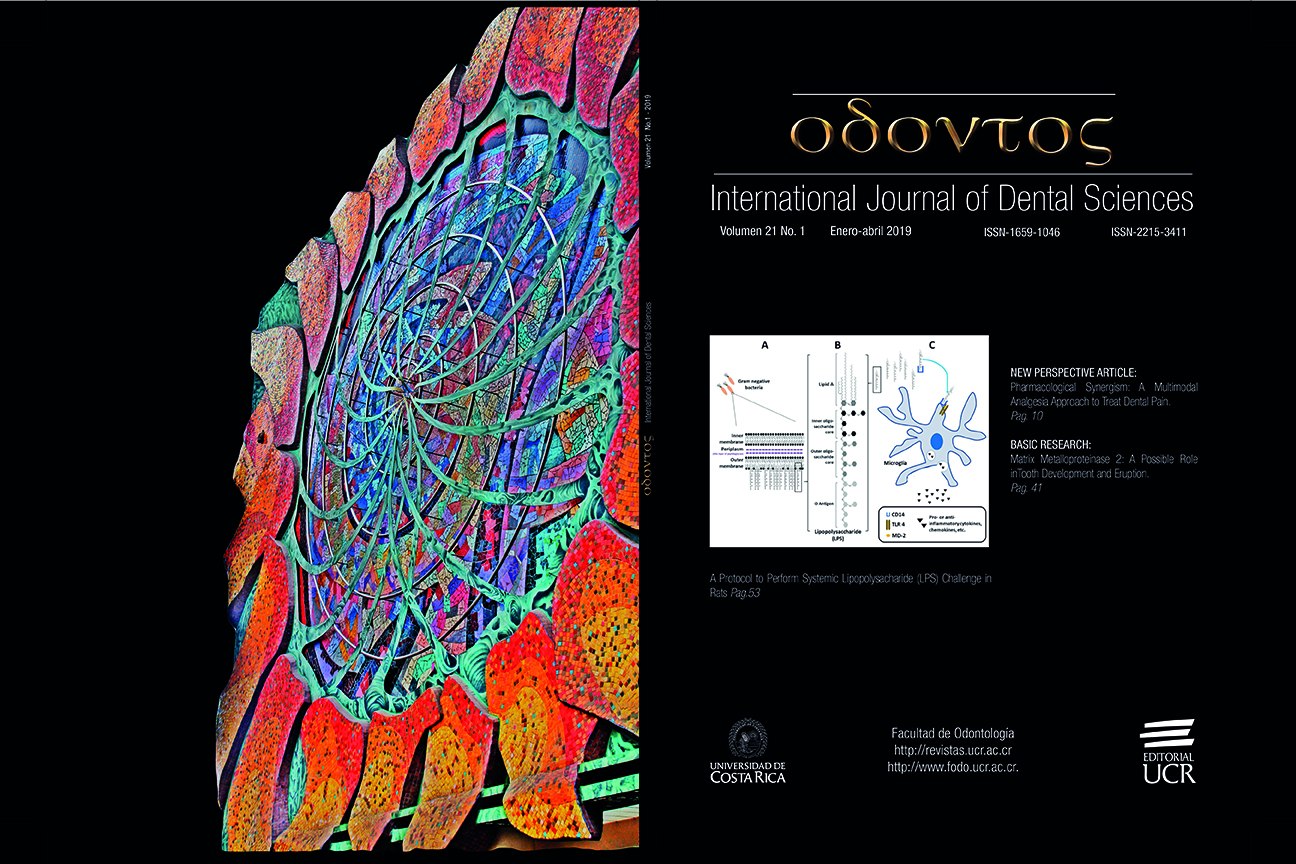Abstract
Conventional glass ionomer cements are used as dental provisional restorative materials, which present several advantages such as adhesion to the tooth mineral phase among others. On the other hand, the knowledge about biological property of glass ionomers shows various approaches and results. In this work, it was studied the in vitro biological response of human gingival fibroblasts in contact with commercial cements of glass ionomer: Mirafil® and Ionglass® and with their extracts, according to ISO 10993. The extracts of the cements, in which the cells were cultured, were adjusted at different concentrations ranging 0.1% to 100%. The cellular metabolic activity of gingival fibroblasts was measured using the Alamar Blue® reagent. The results showed a significant effect on the cellular metabolic activity correlated with the concentration of liberated ions (Al³+ and Ca²+) for both ionomers, as well as the pH variations of the culture media. This could mean that the cellular metabolic activity is substantially influenced by ions and pH of the cell culture.
References
Monmaurapoj N., Soodsawang W., Tanodekae W., Channasanoo N. Effect of Glass Preparation on Mechanical Properties of Glass Ionomer Cements. J of Metals, Materials and Minerals 2010; 20: 197-9.
Gao W., Smales R. J. Fluoride release/uptake of conventional and resin-modified glass ionomers, and compomers. J Dent 2001; 29: 30-6.
Bullard R. H., Leinfelder K. F., Russell C. M. Effect of coefficient of thermal expansion on microleakage. J Am Dent Assoc 1998; 116: 871-4.
Erickson R. L., Glasspoole E. A. Bonding to tooth structure: a comparison of glass ionomer and composite-resin systems. J Esthet Dent 1994; 6: 22-44.
Leyhausen, G., Abtahi, M., Karbakhsch, M., Sapotnick, A., & Geurtsen, W. Biocompatibility of various light-curing and one conventional glass-ionomer cement. Biomaterials, 1998;19 (6), 559-564.
Schmid-Schwap M., Franz A., Cytotoxicity of four categories of dental cements. Dent Mater 2009; 25: 360-8.
Koulaouzidou, E. A., Papazisis, K. T., Economides, N. A., Beltes, P., & Kortsaris, A. H. (2005). Antiproliferative effect of mineral trioxide aggregate, zinc oxide-eugenol cement, and glass-ionomer cement against three fibroblastic cell lines. Journal of Endodontics, 2005; 31 (1), 44-46.
Schedle A., Franz A., Rausch-Fan X. H., Spittler A., Lucas T., Samorapoompichit P., Sperr W., Boltz-Nitulescu G. Cytotoxic effects of dental composites, adhesive substances, compomers and cements. Dent Mater 1998; 14: 429-40.
Sasanaluckit, P. A. K. R., Albustany, K. R., Doherty, P. J., & Williams, D. F. (1993). Biocompatibility of glass ionomer cements. Biomaterials, 14 (12), 906-916.
Sidhu S., Schmalz G. The biocompatibility of glass ionómero cements materials. Status report. Am J Dentistry 2001; 14: 387-96.
Hatton P., Hurrell-Gillingham K., Brook I. Biocompatibility of glass-ionomer bone cements. J Dent 2006; 34: 598-601.
Brook I., Hatton P. Glass-ionomers: bioactive implant materials. Biomaterials 1998; 19: 565-71.
Giacomelli E., Gonçalves E., Mitsuo H., Belle R., Mayumi L. Development of glass ionomer cement modified with seashell powder as a scaffold material for bone formation. Rev Odonto Cienc 2011; 26: 40-4.
Giannoudis, P. V., Dinopoulos, H., & Tsiridis, E. (2005). Bone substitutes: an update. Injury, 36 (3), S20-S27.
Sheets, J. L., Wilcox, C., & Wilwerding, T. (2008). Cement Selection for Cement-Retained Crown Technique with Dental Implants. Journal of Prosthodontics, 17 (2), 92-96.
Shen C. Dental Cements. In: Anusavice KJ, editor. Phillips´ Science of Dental Materials. 11st ed. Missouri USA: Saunders Elsevier; 2007. Pp. 474.
Øilo G. Biodegration of dental composite/glass ionomer cements. Adv Dent Res 1992; 6: 50-4.
Yli-Urpo, H., Vallittu, P. K., Närhi, T. O., Forsback, A. P., & Väkiparta, M. Release of silica, calcium, phosphorus, and fluoride from glass ionomer cement containing bioactive glass. Journal of biomaterials applications, 2004; 19: 5-20.
Oliva A., Della Ragione F., Salerno A., Riccio V., Tartaro G., Cozzolino A., D’Amato S., Pontoni G., Zappia V. Biocompatibility studies on glass ionomer cements by primary cultures of human osteoblasts. Biomaterials 1996; 17: 1351-6.
Sjögren S., Sjögren G., Effects of glass ionomers and dental resin composites on viability of b-cells and insulin release in isolated islets of Langerhans. Biomaterials 2003; 24: 37416.
Machaca K., Ca 2+ signaling, genes and cell cycle. Cell calcium 2010; 48: 243-50.
Lönnroth E., Einar J. Cytotoxicity of dental glass ionomers evaluated using dimethylthiazol diphenyltetrazolium and neutral red tests. Acta Odontol Scand 2001; 59: 34-9.
Nicholson J., Czarnecka B., Review Paper: Role of aluminum in Glass-ionomer dental cements and its biological effects J. Biomaterials Applicate. 2009; 24: 293-308.

